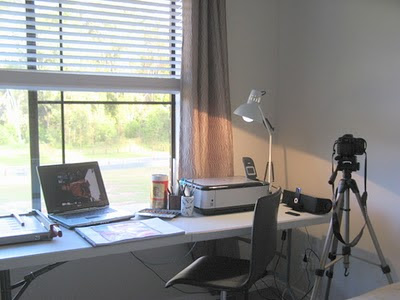An artist without the essential tools to make art is like a pianist with no piano. The last few months I have worked with the bare minimum of equipment – a few tubes of paint and some watercolour paper. In lieu of extra clothes, I packed most of my brushes and some watercolours into my suitcase but the rest came by sea – slowly.
Today I spent a few hours going through an extensive inventory of my goods that have at last been released. I was trying to exercise a little psychic power to remember from the brief note on the box what was near a particular item so I could retrieve desperately needed materials before the rest went into storage for another couple of months.
 |
| The new, improved workspace |
I was able retrieve my printer – in time to print up-dated business cards, oil paints, pastels, and my camera tripod. More importantly, I found a compatible lens in place of the one that decided to make a sound like coffee- grinder – I fear the lens is on its way to camera heaven. (The way I feel about it however, it should go to the warmer place)
 |
| View from my window |
As a creative person you would think that I shouldn’t be so caught up with wanting my stuff - I should be above material things. But really, to be honest, just having these few extra things, plus a larger table, speakers for my iPod, and other bits and pieces, I now feel as though I am really here and not just visiting. There are other things too – yesterday I passed my practical driving test (obligatory when you come from the land of the dodgy license) and this morning at 7.45am had my first ever experience at having a breathalyser test - welcome to Australia....







